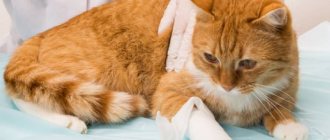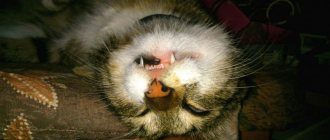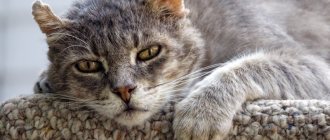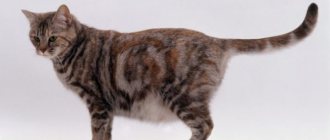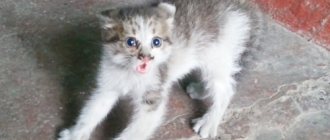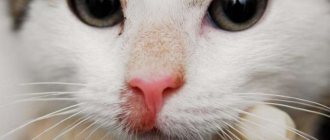When a cat suddenly starts to tremble, it alarms and sometimes even frightens the owners. This phenomenon is called tremor, it is caused by involuntary contraction of one or all muscle groups. There are physiological and pathological reasons for its occurrence, which can only be accurately determined by a veterinary specialist. But in order to provide timely help to the pet, the owner must know the reasons why the cat is trembling.
What is tremor in cats
Tremor in cats is a convulsive contraction of the muscles of the animal’s body, which is visually expressed in the form of small tremors. Sometimes the cat's whole body trembles, but certain parts of it may also shake. Involuntary muscle contraction, called tremor, can also occur in a state of complete rest, indicating maximum relaxation of all muscle groups. However, trembling often indicates that the cat has serious health problems and the animal requires urgent treatment.
Important! If long-haired cats shake with small tremors, then you can only feel it if you put your hand on the animal. But sometimes the tremor is clearly visible and is accompanied by other alarming symptoms.
Hormones
Thinking about why a cat is trembling, let's talk about another reason for this condition. These are hormonal storms. During the period of the so-called gulka, when the animal requires mating, the male can scream furiously, demanding a bride, and suffer from a tremor that covers his entire body, from the tips of his ears to the tail.
This can also be observed in cats. They also often tremble during estrus. It is advisable to prevent such torment of the animal. If you are not planning kittens, then sterilize your pet. After this procedure, the cat will no longer tremble for this reason.
Physiological causes of trembling
Sometimes a cat trembles due to external factors such as a sudden change or decrease in the temperature of the surrounding area. Physiological factors of tremor also include stress, sexual arousal, deep sleep or some reflex processes in the animal’s body.
Cold
You will often notice that your cat will shiver after swimming or spending a long time outside on a cold day. This tremor is a mechanism of thermoregulation and does not allow the animal to freeze for a long period of time.
Pampered domestic cats get chills even with a slight drop in ambient temperature, while a pet hardened by frequent walks can stay outside for a long time, even in severe frosts. Owners should take into account such individual characteristics of their cats’ bodies to determine the duration of the walk, since hypothermia easily leads to the development of colds and inflammatory pathologies.
Important! Even if the room is warm, the animal's fur must be thoroughly dried after bathing. It is also important to ensure there are no drafts and not to allow the cat to lie on a cold surface.
Emotional excitement
The cat may tremble as if it were cold when there is strong emotional arousal, positive or negative. Both during fear and during times of great joy, a large amount of certain hormones enter the animal’s bloodstream, which provoke muscle tremors.
By this sign you can determine the mood of your pet. For example, when nervous, a cat shakes as if frozen, arches its back, hisses or meows loudly. Sometimes the readiness to attack is expressed only in the shaking of the tail raised up. At the same time, sitting on the lap of its beloved owner, the animal may tremble slightly and purr with pleasure.
Sexual arousal
During the period of sexual heat, all the senses of male cats become more acute. In the absence of a sexual partner, animals are constantly nervous, strive to get out of the house, and may show aggression or excessive intrusiveness. The cat is shaking from the powerful release of sex hormones into the blood. This condition leads not only to mental disorders of the animal, but also provokes the development of malignant tumors of the reproductive organs and mammary glands. Therefore, the most humane way to get rid of the suffering of cats and female cats that do not take part in breeding is castration.
Other reasons
Some cats may experience tremors as a reflex after eating food. It is especially common to notice how a well-fed kitten trembles in its sleep and does not show signs of anxiety.
Sometimes owners have a question about why the cat trembles when he sleeps. Experts even have a special term “sleepy tremor,” which indicates maximum relaxation of all muscles.
A cat may also shiver in its sleep when sleeping indoors with low air temperatures. This is indicated by the animal’s posture - the cat curls up into a tight ball, “burying” its nose as deeply as possible into the fur or under the paw.
Important! If the cat is shaking in its sleep, trying in vain to warm its frozen limbs, but at the same time the room is quite comfortable and warm, then you should measure the pet’s temperature. Her sharp decline indicates a very serious pathology that is life-threatening.
Poor and restless sleep, which is accompanied by periodic twitching of the limbs and tremors in the body, may be a consequence of stress or prolonged physical exertion. Most often, owners observe this condition in their pet after he “defended his rights” to a female during the period of sexual heat.
“Senile tremor” can also be considered normal. Poor circulation and innervation is the reason why an elderly cat shakes when lying or sitting in a relaxed state.
Emotional excitement
What to do if your cat is shaking? First you need to find out the reason, and only then take some action. For example, periodic trembling in an animal may appear due to certain emotional states. For example, the cat experienced severe fear, discomfort from the appearance of strangers in the apartment, and aggression arose.
Note that not only negative emotions can cause such conditions in a pet. For example, a cat that is experiencing bliss may also tremble periodically. Some owners notice that when they return after work and the cat is bored, rubs, purrs, and literally shakes with joy. This is the normal state of the animal. Therefore, you should not leave your pet for a long time if it is so hard for you to be separated from you.
Pathological causes of tremor
The reason why the cat is trembling as if he is cold, although he is at home in comfortable conditions, may be pathological factors. In this case, tremor is often accompanied by the following clinical symptoms:
- photophobia;
- inactivity and lethargy;
- aggression;
- pain syndrome;
- increased body temperature;
- diarrhea or constipation;
- vomit;
- purulent discharge from the nasal cavity or eyes;
- impaired coordination of movements.
Often, the presence of pathology in a cat is indicated by trembling of individual parts of the body or muscle groups, when only the head, front or hind limbs shake.
Important! Tremor must be distinguished from convulsions, which are always accompanied by pain. In kittens up to 5-6 months of age, when their central nervous system is intensively developing, seizures can be physiological in nature. In other cases, seizures indicate the presence of serious disorders of brain function caused by infectious or traumatic factors.
There are many pathological reasons why kittens and adults tremble.
A deficiency of calcium and B vitamins in the body provokes degenerative processes in muscle tissue in cats.
The reason that the kitten is trembling may be infectious rhinotracheitis. In addition to tremor, this disease is accompanied by cough, purulent discharge from the eyes and nose, a significant increase in body temperature and digestive disorders.
With the development of helminthic infestations, when helminths clog the pet's intestines and release a huge amount of toxic products of their vital activity, the kitten experiences symptoms of intoxication, it becomes lethargic and trembles all over its body.
The body's response to the introduction of general anesthesia. If the cat shakes for more than 6 hours after surgery, this may indicate the development of internal bleeding. In this case, urgent medical intervention is necessary.
Body tremors in cats are provoked by acute inflammatory processes in the organs of the genitourinary system and attacks of urolithiasis.
Otitis media, caused by ear mites or other factors, leads to frequent head twitching. The cat scratches the sore ear, hits it, tilts its head towards the affected organ. As a result, scratches and hematomas appear in the ear area. Lack of treatment leads to inflammation spreading to the inner ear and meninges, which provokes death.
During acute liver failure, the cat develops vomiting and diarrhea; at the initial stage, it trembles slightly, and at the stage of failure of the affected organ, it trembles all over.
Head tremor may indicate traumatic brain injury, encephalitis, cerebellar lesions, or drug overdose.
If a kitten walks poorly and his whole body shakes, this may indicate spinal column injuries caused by congenital pathologies, compression or bruises. In adult cats, such symptoms are the result not only of injury, but also the development of tumors or deformation of the intervertebral discs.
If a kitten suddenly becomes lethargic, begins to tremble, first slightly, and then with increasing amplitude, then such tremors and lethargy most often indicate poisoning. If the baby is not taken to the clinic, he will develop seizures and die.
The cause of tremor may be borreliosis, which occurs after a tick bite. The insidiousness of the disease lies in its long latent period, when clinical signs may appear several months after infection.
Tremor combined with lethargy may be one of the signs of toxoplasmosis in cats.
If a kitten walks poorly, shakes, spins in place, or is poorly oriented in space, this may indicate that he has such a serious congenital pathology as hydrocephalus.
Tremors of the limbs, turning into convulsions, can occur in a cat during childbirth or within a week after it. This phenomenon is called eclampsia. It indicates an acute lack of calcium in the animal’s body. If left untreated, your cat will develop seizures, which can be fatal.
When to see a doctor
If a cat's tremor is accompanied by fever, indigestion or pain, the animal must be urgently taken to the clinic or a veterinarian called to your home.
Also, a cat whose trembling turns into convulsions or epileptic attacks requires immediate hospitalization.
Sometimes the owner cannot understand why a kitten or an adult cat is shaking violently, and at the same time she arches her back, meows quietly, and tries to burp. Such signs usually indicate ingestion of a foreign object that is causing pain or discomfort. In this case, the animal can only be saved in a clinical setting if the object is surgically removed in a timely manner.
Russian cats and cucumbers
There is an assumption that Russian cats are not afraid of cucumbers. But unfortunately, this is not true. Therefore, the appearance of a long green vegetable will cause fear in them too. Although, of course, each cat has its own character. Some animals are more timid, while others are brave and more resistant to stressful situations. Therefore, the “nationality” of cats has nothing to do with it.
The fear of cucumbers is based on two circumstances. The first is surprise. That is, the animal, seeing an unfamiliar object, begins to panic and rush around. The second is instincts. A cat's reaction to a new long green object is a classic manifestation of the self-preservation instinct.
Diagnostics
You can decide what to do if a kitten or adult cat is trembling only after determining the causes of the tremor. In most cases, it is impossible to do this yourself at home. However, you need to carefully monitor the animal’s behavior in order to answer the following questions for your veterinarian:
- frequency of repetitions and duration of attacks during the day;
- the presence of accompanying symptoms;
- events preceding the onset of tremor;
- dates of the last deworming and vaccination.
It is also necessary to remember whether the cat was bitten by a tick during the year.
To make an accurate diagnosis, the following studies may be prescribed:
- general and clinical blood test;
- Analysis of urine;
- fecal analysis for the presence of helminths;
- radiography of the head, spine, chest and abdominal cavity;
- MRI or CT scan of the brain;
- myelography – to detect spinal tumors and intervertebral disc pathologies;
- electromyography.
A cerebrospinal fluid tap may be taken to confirm encephalitis.
Treatment
Physiological tremor in cats does not require medical intervention. To eliminate it, it is enough to minimize stress factors, provide the animal with comfortable living conditions and a nutritious, balanced diet.
If there are regular bouts of trembling, the animal must be shown to a veterinarian.
Important! You cannot independently relieve attacks of tremor in cats using sedatives or antispasmodics intended for humans. This can provoke complications or blur the clinical picture of the disease, which will significantly complicate the diagnosis.
Treatment of pathological tremor in cats consists of eliminating the cause of its occurrence. It can be expressed in the prescription of sedatives and anthelmintic drugs. In the presence of infectious processes, antimicrobial and symptomatic therapy is carried out. In the case of neoplasms or serious pathologies of the nervous or musculoskeletal system, surgical intervention is prescribed.
If the owner notices nervous twitching of the body in his cat, he needs to undergo a full course of examination at the clinic. This will help to identify the pathology in a timely manner and begin appropriate treatment. If the tremors are a consequence of poor nutrition or care, the veterinarian will point out the shortcomings and make adjustments that will help avoid the appearance of tremors in the future.
